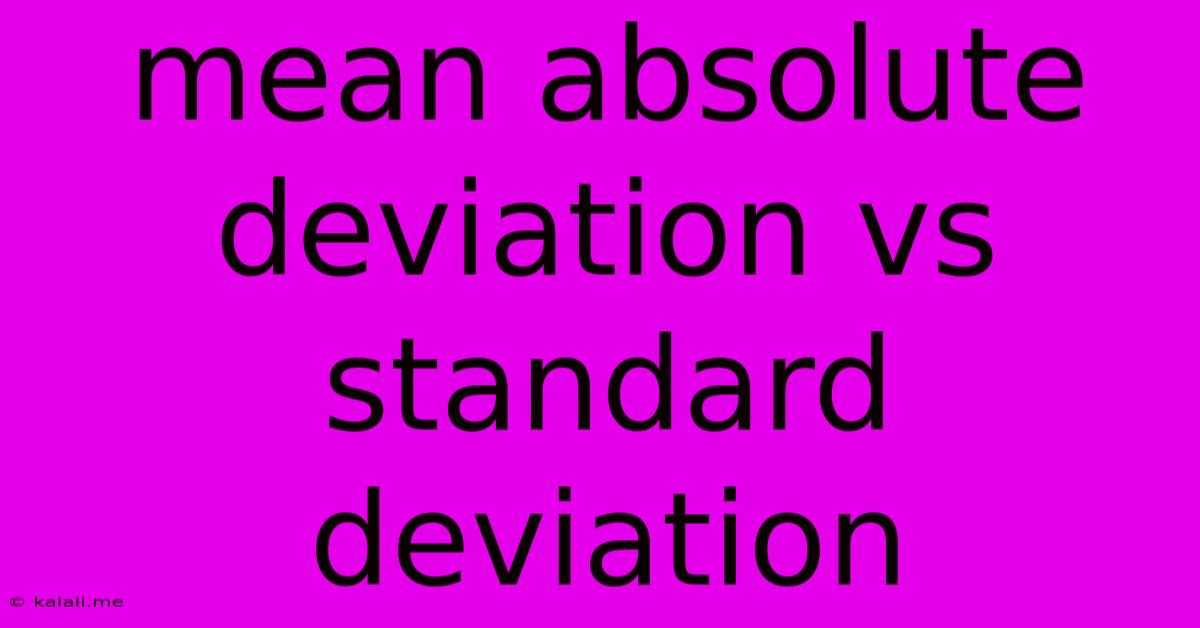Mean Absolute Deviation Vs Standard Deviation
Kalali
Jun 08, 2025 · 3 min read

Table of Contents
Mean Absolute Deviation vs. Standard Deviation: Which Measure of Dispersion Should You Use?
Understanding the spread or dispersion of your data is crucial in statistics. Two common measures for this are the Mean Absolute Deviation (MAD) and the Standard Deviation (SD). While both quantify how far data points are from the mean, they differ in their calculation and interpretation. This article will delve into the differences between MAD and SD, helping you determine which measure best suits your analytical needs. Choosing the right measure depends heavily on your data's characteristics and your specific goals.
What is Mean Absolute Deviation (MAD)?
The Mean Absolute Deviation is the average of the absolute differences between each data point and the mean of the data set. It's a simple, intuitive measure of variability. In essence, it tells you the average distance of each data point from the center of the distribution. The calculation is straightforward:
- Calculate the mean: Sum all data points and divide by the number of data points.
- Find the absolute differences: For each data point, subtract the mean and take the absolute value (ignore negative signs).
- Calculate the average of these differences: Sum the absolute differences and divide by the number of data points.
Advantages of MAD:
- Easy to understand and calculate: Its simplicity makes it accessible to a wider audience, even those with limited statistical knowledge.
- Robust to outliers: Because it uses absolute differences, MAD is less sensitive to extreme values (outliers) compared to standard deviation. Outliers don't disproportionately inflate the MAD.
Disadvantages of MAD:
- Less commonly used: Compared to standard deviation, MAD is less frequently employed in statistical analysis and may not be supported by all statistical software packages.
- Mathematical limitations: It's not as widely used in advanced statistical techniques that rely on the properties of variance and standard deviation, such as hypothesis testing.
What is Standard Deviation (SD)?
Standard deviation measures the spread of a data set by calculating the square root of the variance. The variance is the average of the squared differences from the mean. This means it considers how far each data point deviates from the mean, but it squares these deviations before averaging them. Squaring amplifies the effect of larger deviations.
Advantages of SD:
- Widely used and understood: SD is the most common measure of dispersion in statistics and is used extensively in various statistical methods and software.
- Mathematical properties: It possesses desirable mathematical properties making it suitable for advanced statistical analysis, including hypothesis testing and regression analysis.
- Interpretable within a normal distribution: In a normal distribution, approximately 68% of data falls within one standard deviation of the mean, 95% within two standard deviations, and 99.7% within three standard deviations.
Disadvantages of SD:
- Sensitive to outliers: Outliers significantly impact the standard deviation, potentially inflating the measure of spread.
- More complex calculation: The calculation is slightly more involved than MAD, requiring squaring and square rooting.
MAD vs. SD: Choosing the Right Measure
The choice between MAD and SD depends on your specific needs and the nature of your data:
-
Use MAD when:
- Simplicity and ease of understanding are prioritized.
- Your data contains significant outliers that could skew the standard deviation.
- You need a robust measure less influenced by extreme values.
-
Use SD when:
- You need a measure widely used in statistical analysis and supported by statistical software.
- You're working with data that is approximately normally distributed.
- You'll be performing advanced statistical techniques that rely on the properties of variance and standard deviation.
Ultimately, understanding the strengths and weaknesses of both MAD and SD empowers you to choose the most appropriate measure of dispersion for your data analysis, leading to more accurate and insightful conclusions. Consider the context, the characteristics of your dataset, and the subsequent statistical analyses you plan to conduct before making your decision.
Latest Posts
Latest Posts
-
Square Root Of 2 Times 2
Jun 08, 2025
-
Does Pongalos Have An Accent Mark
Jun 08, 2025
-
How To Know The Brand Of A Generic Headphone Jack
Jun 08, 2025
-
How To Get A Sawmill In Terraria
Jun 08, 2025
-
Volume Of Sphere By Triple Integration
Jun 08, 2025
Related Post
Thank you for visiting our website which covers about Mean Absolute Deviation Vs Standard Deviation . We hope the information provided has been useful to you. Feel free to contact us if you have any questions or need further assistance. See you next time and don't miss to bookmark.